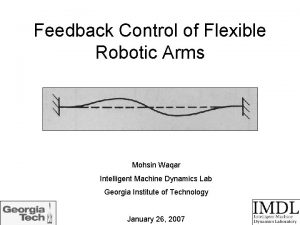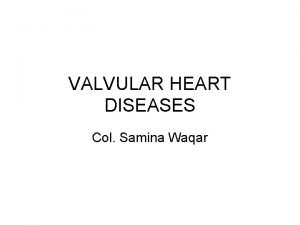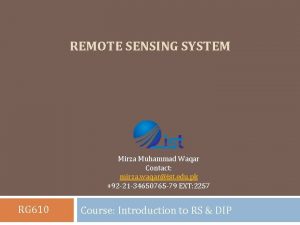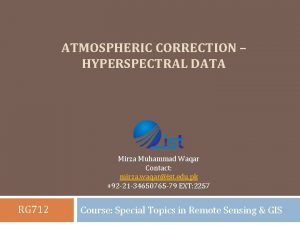INTERACTION OF EM WITH ATMOSPHERE Mirza Muhammad Waqar
















- Slides: 16

INTERACTION OF EM WITH ATMOSPHERE Mirza Muhammad Waqar Contact: mirza. waqar@ist. edu. pk +92 -21 -34650765 -79 EXT: 2257 RG 610 Course: Introduction to RS & DIP

Outlines Remote Sensing System � � � The Energy Source The Atmosphere The Energy-Matter Interaction at the Earth’s Surface The Sensor The data processing and supply system The multiple data users An ideal Remote Sensing System

Remote Sensing System 3

Electromagnetic Radiations c=fλ c = 3 x 108 m/sec Either f , λ can be used for characterization of EM radiations.

Electromagnetic Radiation Remote sensing is based on detecting electromagnetic (EM) energy. Since the speed of light is constant, wavelength and frequency are inversely related to each other.

Electromagnetic Radiation 6

Black Body Radiations

Energy Interactions in the Atmosphere 8 Irrespective of its source, all radiations detected by remote sensors passes through some distance of atmosphere The path length can vary widely depending upon � � Source of illumination elevation angle Sensor view angle Following phenomena can take place, while interaction of energy in atmosphere. � � Scattering Absorption

Scattering occurs when particles or large gas molecules present in the atmosphere interact with and cause the electromagnetic radiation to be redirected from its original path. Type of Scattering � Raleight Scattering � Mie Scattering � Non Selective Scattering

Rayleigh Scatter Rayleigh scatter is common when radiation interacts with atmospheric molecules and other tiny particles that are much smaller in diameter than the wavelength of interacting radiation. The effect Rayleigh scatter is inversely proportional to the fourth power of wavelength. Hence shorter wavelengths will scatter more by Rayleigh scatter.

The Blue Sky ~ A “blue” sky is a manifestation of Rayleigh scatter. In the absence of scatter, the sky would appear black. Sunlight interacts with the earth’s atmosphere, � It scatter the shorter (blue) wavelength more dominantly than the other visible wavelengths. � Consequently, we see a blue sky.

Mie Scattering Mie scattering occur when atmospheric particle diameters essentially equal the wavelengths of the energy being sensed. Water vapors, dust particles are major causes of Mie scatter influence longer wavelengths as compared to the Rayleigh scatter.

Non-Selective Scattering It occurs when the diameter of the particles causing scatter are much larger than the wavelengths of the energy being sensed. Water droplets, for example causes such scatter. This scattering is “nonselective” with respect to wavelength. Hence in visible, equal quantities of blue, green and red light are scatter, hence fog and cloud appear white in satellite images.

Absorption Atmospheric absorption results in the effective loss of energy. The most efficient absorbers of solar radiation in atmosphere are � Water vapor � Carbon dioxide � Ozone The wavelength range in which the atmosphere is particularly transmissive of energy are referred to as atmospheric windows.

Atmospheric Windows 15 The wavelength ranges in which the atmosphere is particularly transmissive of energy are referred to as atmospheric windows.

Questions & Discussion































